WHERE ARE THEY NOW?
PART TWO (Missed part one? Read here)
Fifty years ago, BR allowed steam to run to Shildon under its own power for the big S&D 150 event. HOWARD JOHNSTON reveals that some invited engines – including National Collection ‘Battle of Britain’ Winston Churchill – didn’t make it.

More than 30 of our most famous steam locomotives ran in the cavalcade at the ‘Rail 150’ festival at Shildon on August 31 1975. But it can now be revealed that the original intention was to have more than twice that number.
Bulleid ‘Battle of Britain’ 4 6 2 No. 34051 Winston Churchill was on the initial invitation list, a rather bold move considering that it has still not been steamed 50 years later. LNER ‘A2’ No. 60532 Blue Peter and GWR ‘Castle’ 4 6 0 No. 4079 Pendennis Castle were two other celebrity no-shows because they could not be got ready in time.
No matter. Months of meticulous planning ensured that the week-long festival, the third of its kind after 1875 and 1925, was an outstanding success, thanks to the dedication to detail by British Rail staff at all levels, and private railways and owners who willingly loaned the exhibits. The key criteria was that the locomotives could run to the North East under their own power (road haulage of large railway items was in its infancy, and BR certainly did not have the resources to provide diesel haulage). There was the added challenge of finding enough qualified drivers and firemen some seven years after the end of regular steam in the North West.
Half a century on it is not easy to establish the identities of all 65 locomotives intended to participate, but access to an official list published in spring 1975 at least give details of some of them. The Severn Valley Railway, provider of several engines, was also asked for pioneer BR 4 6 2 No. 70000 Britannia and LNER ‘Mogul’ No. 3442 The Great Marquess, which were both Bridgnorth residents at the time. The SVR has since explained Britannia needed too much work. It had arrived there in 1971 in a quite battered state, and repairs to its firebox were a long job. The SVR was, however, able to offer WD 2 10 0 No. 600 Gordon after a hurried repaint in Longmoor Military Railway blue, and working engines, Stanier ‘8F’ 2 8 0 No. 8233 (48773) Ivatt 2 6 0 No. 43106, just needed a quick spruce-up.
Southern Railway ‘Spam Can’ Winston Churchill was intended to be accompanied to Shildon by ‘Q1’ 0 6 0 No. 33001, but both would stay in a shabby state in the old Pullman works at Preston Park, Brighton for another year or so. The East Somerset Railway was approached for ‘Schools’ 4 4 0 No. 928 Stowe, but it too was in an unsuitable condition.

Also advertised to appear (but they didn’t) were Midland ‘Half Cab’ 0 6 0T No. 1708, and the National Collection’s 1874 Stockton & Darlington ‘long boiler’ 0 6 0 No. 1275, which had been in the 1925 cavalcade.
Although other engines couldn’t run in the cavalcade, they did make it to Shildon for static display, some actually arriving by road. Mainland Europe was represented by the Danish State Railways Hartmann 0 4 0WT No. 385; the Middleton Railway sent NER ‘H’ 0 4 0T No. 1310 and LNER Sentinel No. 54 (68153); the KWVR dispatched its 1893-built Hudswell, Clarke 0 4 0ST Lord Mayor, and Beamish its 1871 Head Wrightson 0 4 0 vertical boiler ‘Coffee Pot’. The SVR’s ex Port Talbot Railway 0 6 0ST No. 813 was not on the original list, but nevertheless welcome. Early non-steam was represented by 1916 Baguley petrol 60hp four-wheeler Jacob from Dinting, and 1934 Drewry diesel WD240 (LMS 7050, now at the NRM).
BR boss on top form
Much of the credit for the smoothness of BR’s local operations goes to Darlington’s Area Manager, the late Archie Brown, who commented that August 31 1975 was the “most exciting, exhilarating and satisfying day that I experienced in all my 40 years of railway operational involvement.”
Visitors were funnelled in their thousands through Darlington station. Its vastness allowed it to fulfil the regular East Coast Main Line timetable, plus local servies to Eaglescliffe, Middlesbrough and the Esk Valley line to Whitby. Platform 1 was used for ‘Rail 150’ specials from King’s Cross (4), St Pancras, Plymouth, Bristol, Liverpool, Manchester, Leicester, Ipswich, Sheffield, Keighley, Chesterfield, Grantham, Doncaster, and Huddersfield. Platform 4 was allocated to intensive shuttles to Shildon on the branch to Bishop Auckland, in normal times only used sporadic local services.
Seventeen specials were run; the procession of locomotive-hauled trains arrived, disgorged their contents, and sped off to suitable stabling points for running round and servicing for the journey home. The yards at Heaton, York, Tyne Yard and Leeds Neville Hill were all heavily stacked, and one has to wonder how BR found so many coaches.
The ‘Rail 150’ celebrations continued for another month, with BR running excursions with steam haulage between Sheffield and Newcastle, using LNER Nos. 1306, 4472, 4498 and 4771.
Main line, museum, and worse: What’s happened to the exhibits?
(Engines listed in order of appearance)
In the last issue, we listed the order of appearance of the first 21 locomotives in the cavalcade. This is the second part.
Engines were tightly timed to run at two-minute intervals between Shildon and Heighington, restricted to 5mph, and crews under strict instruction to maintain the correct space behind the preceding exhibit. They also had to sound their whistles when they passed trolleys carrying the television and film crews.
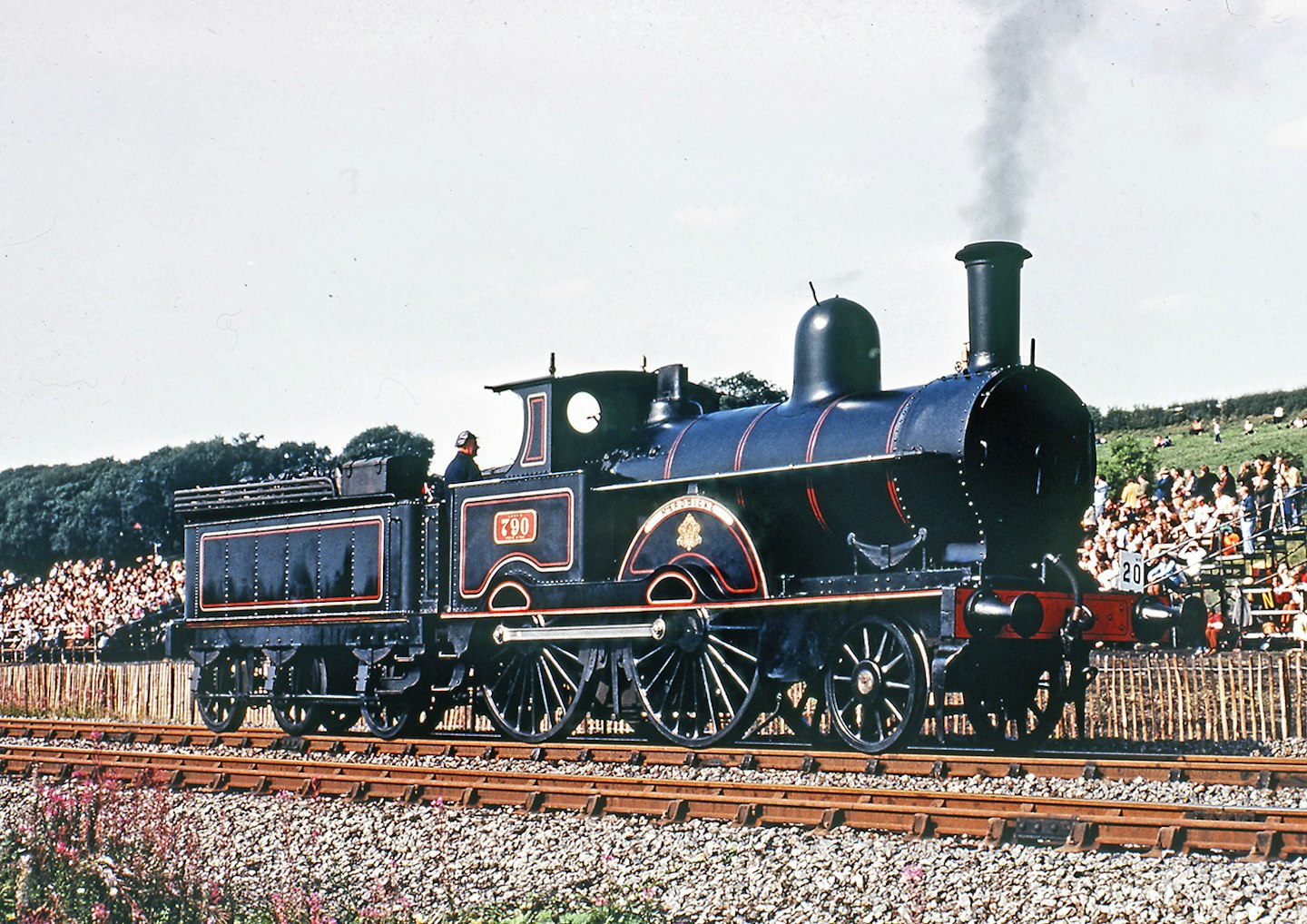
LNWR ‘Improved Precedent’ 240 No. 790 Hardwicke
1975: Carnforth
2025: Shildon
Status: Static display
Returned to steam just weeks before the Shildon event, this Webb-designed 240 was already a history maker, having achieved over 90mph during its 2hr 6min run over the 141 miles between Crewe to Carlisle in the August 1895 ‘Races to the North’, a record that stood for almost 40 years. Preservation was guaranteed when it was withdrawn in 1932, and although it had a short career on main line railtour duty up until 1982, it seems a pity that it is now just a static exhibit.
Midland Railway ‘Compound’ 440 No. 1000
1975: NRM, York
2025: Barrow Hill
Status: Static display
The pioneering 1902 Midland ‘Compound’ was a rose among thorns between 1959-62, having been restored at Derby to Crimson Lake livery (with an S&D ‘7F’ tender) for main line specials before static retirement at Clapham Museum. It was moved to York in 1975, and revived for the ‘Rail 150’ cavalcade.
Laid aside again in 1983 after extensive use on main line specials, No. 1000 has been displayed at a variety of preservation centres, including the ill-fated Dinting Railway Centre, Bo’ness, Highley, the Derby Litchurch Lane ‘175’ event in 2014, and most recently Barrow Hill. It would be a popular engine if the finance was available to return it to steam.
LMS ‘Jubilee’ 460 No. 5690 Leander
1975: Dinting
2025: Carnforth
Status: Under overhaul
This three-cylinder ‘Jubilee’ was a familiar sight on the North East-South West cross-country route for 18 years until withdrawn from Bristol Barrow Road shed in 1964, and spent eight years at Barry before its rescue by businessman Graham Oliver and restoration at great expense at Derby Works.
Leander had a long spell on the main line, but participation in the 1975 cavalcade was a highlight. After ownership by the Severn Valley Railway from 1983-94 it was taken over by Dr Peter Beet and operated by West Coast Railways. Its boiler certificate expired in 2024, but that’s not the last you’ll hear of it.
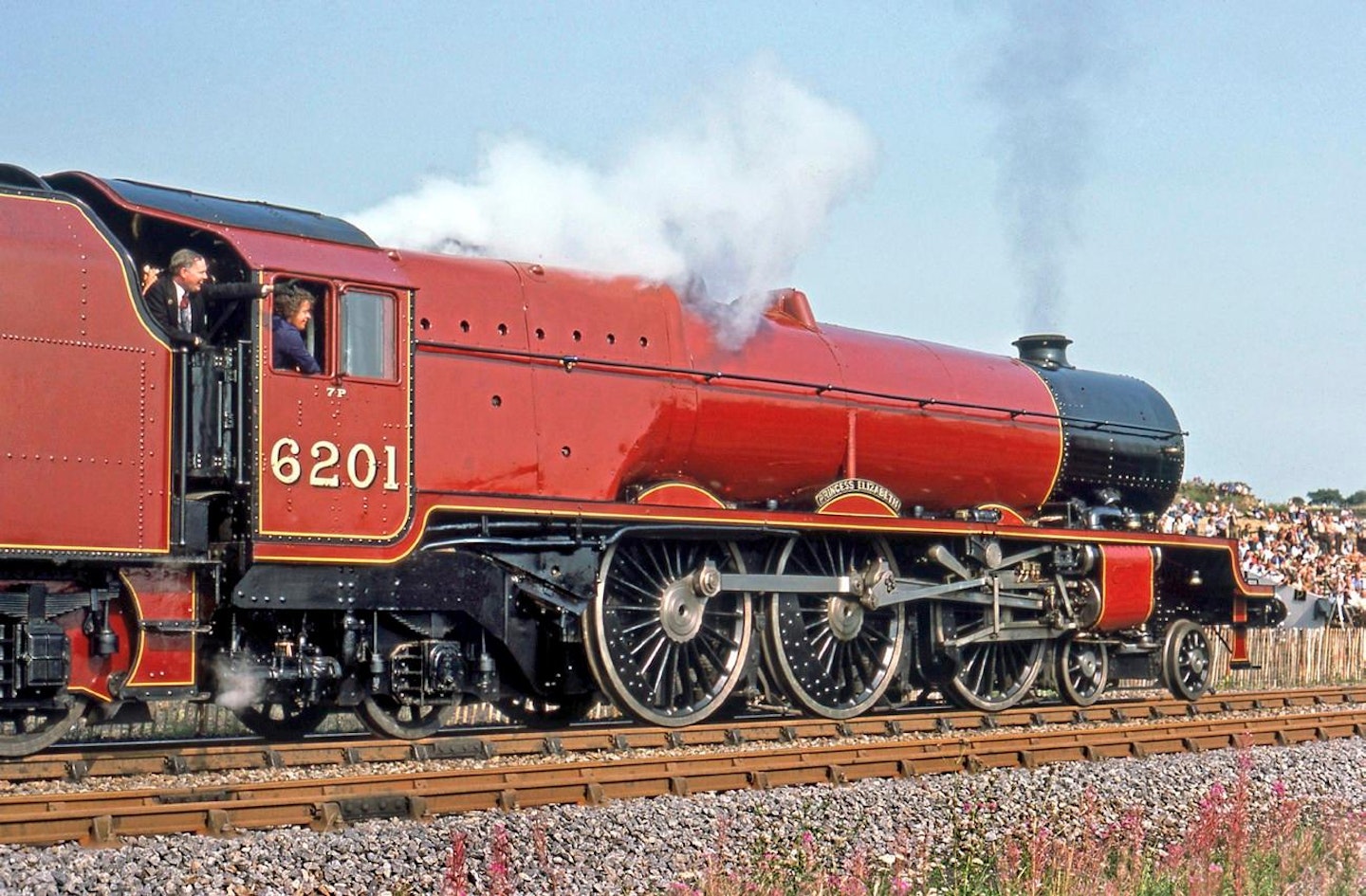
LMS ‘Princess Royal’ No. 6201 Princess Elizabeth
1975: Ashchurch
2025: Carnforth
Status: Under overhaul
The mighty Stanier ‘Pacific’ that could haul 600 ton-expresses of 17 coaches over Shap and Beattock on the West Coast Main Line was an early preservation entrant when it was withdrawn in 1962. It is, reputedly, written into the owning society’s constitution that ‘Lizzie’ will never be painted in anything but LMS Crimson Lake, so a green No. 46201 seems forever out of the question.
After storage at Ashchurch and Hereford, it was restored in time for ‘Rail 150’, and has broadly been a main line regular ever since, including hauling Queen Elizabeth herself during her Diamond Jubilee tour in 2012. It was withdrawn in July 2021 with boiler issues, but while the repair bills have been monumental, its return to service is in prospect.
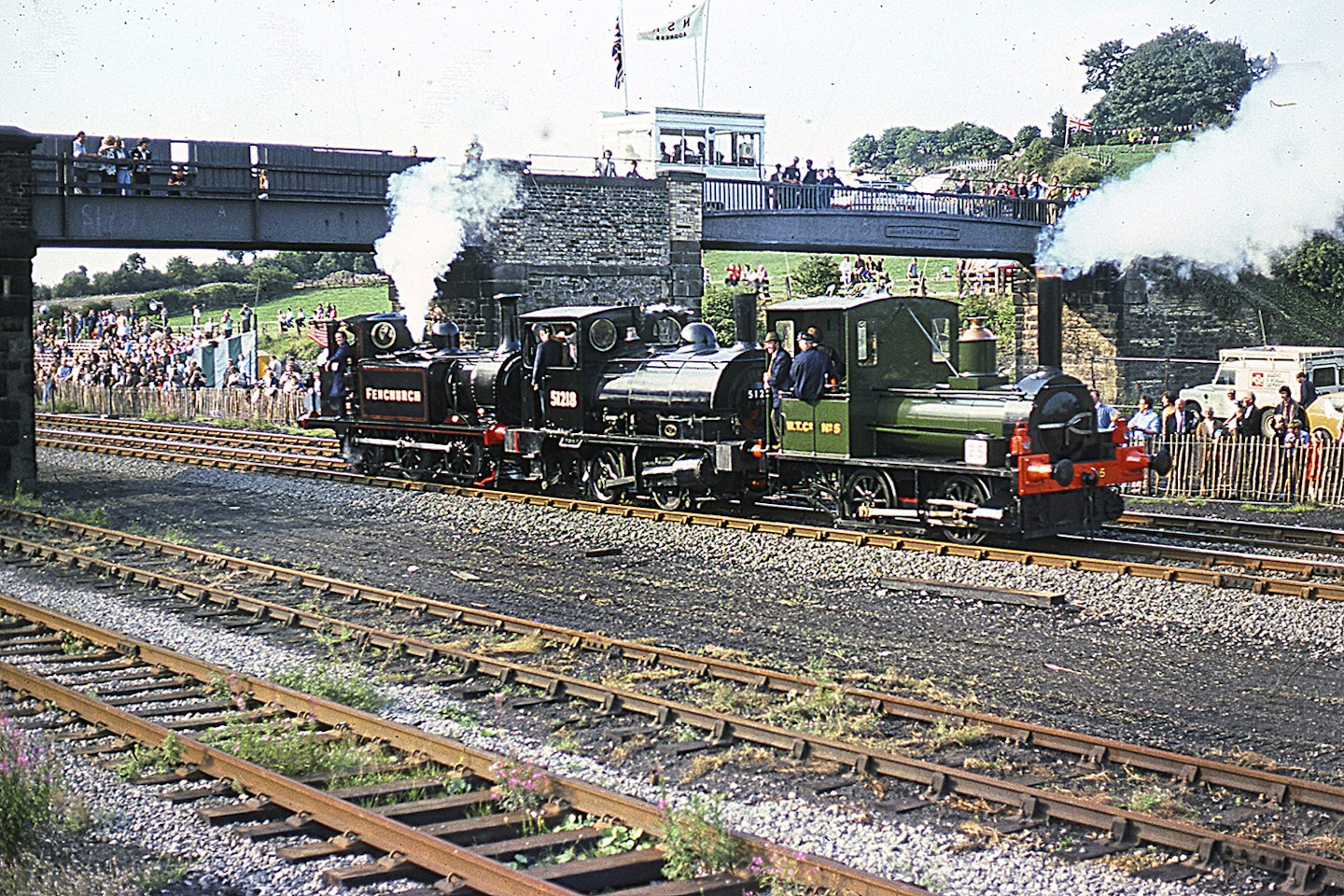
Wantage Tramway Company 040WT No. 5
1975: Didcot
2025: Didcot
Status: Static display
The oldest and smallest locomotive in steam at Shildon arrived on a Lowmac wagon without its chimney. Built in 1857 for the Sandy & Potton Railway, the well tank was sold to the LNWR in 1862, then on to the Wantage Tramway in 1878, when it famously ran from Crewe under its own power.
Although visually resplendent, No. 5 was taken out of service shortly after the 1975 cavalcade with serious firebox defects, last steaming at Didcot in 1976. Now painted WTC red, the George England-designed engine is back on display at Didcot Railway Centre.
Lancashire & Yorkshire Railway ‘21’ 040ST No. 51218
1975: Keighley & Worth Valley Railway
2025: Keighley & Worth Valley Railway
Status: Static display
The immaculate tiny Aspinall ‘Pug’ was one of the stars of ‘Rail 150’, with its crews taking great care to manage its meagre coal and water supply, and ensuring that its axleboxes didn’t overheat by driving it too fast.
No. 51218 was still in good order when it was withdrawn from service at Neath in 1964, cheaper to buy for preservation than ‘Radial’ No. 50850. The first arrival at the KWVR’s Haworth shed, it was retubed for the 1975 Shildon gala. This revival was short-lived, and it didn’t return to steam properly until 1997, running until 2006. It has a replacement saddle tank, but awaits a business plan for a return to steam.

London, Brighton & South Coast Railway ‘Terrier’ 060T No. 72 Fenchurch
1975: Bluebell Railway
2025: Bluebell Railway
Status: Operational
Considered an extremely elderly engine even back in 1975, the Stroudley ‘A1X’ 0 6 0T is now a remarkable 153 years old, and yet another full scale rebuild (completed in October 2022) has included an all-new firebox and cylinder block and repaint in LBSCR umber livery. The itinerant ‘Terrier’ appeared at Shildon in all-over black with the name Fenchurch on its tanks, and its coal noticeably whitewashed. Cosmetically returned to ‘A1’ condition in 2001, nowadays No. 72 is a regular performer at the Bluebell Railway, which has been its home since withdrawal from BR service in May 1964.
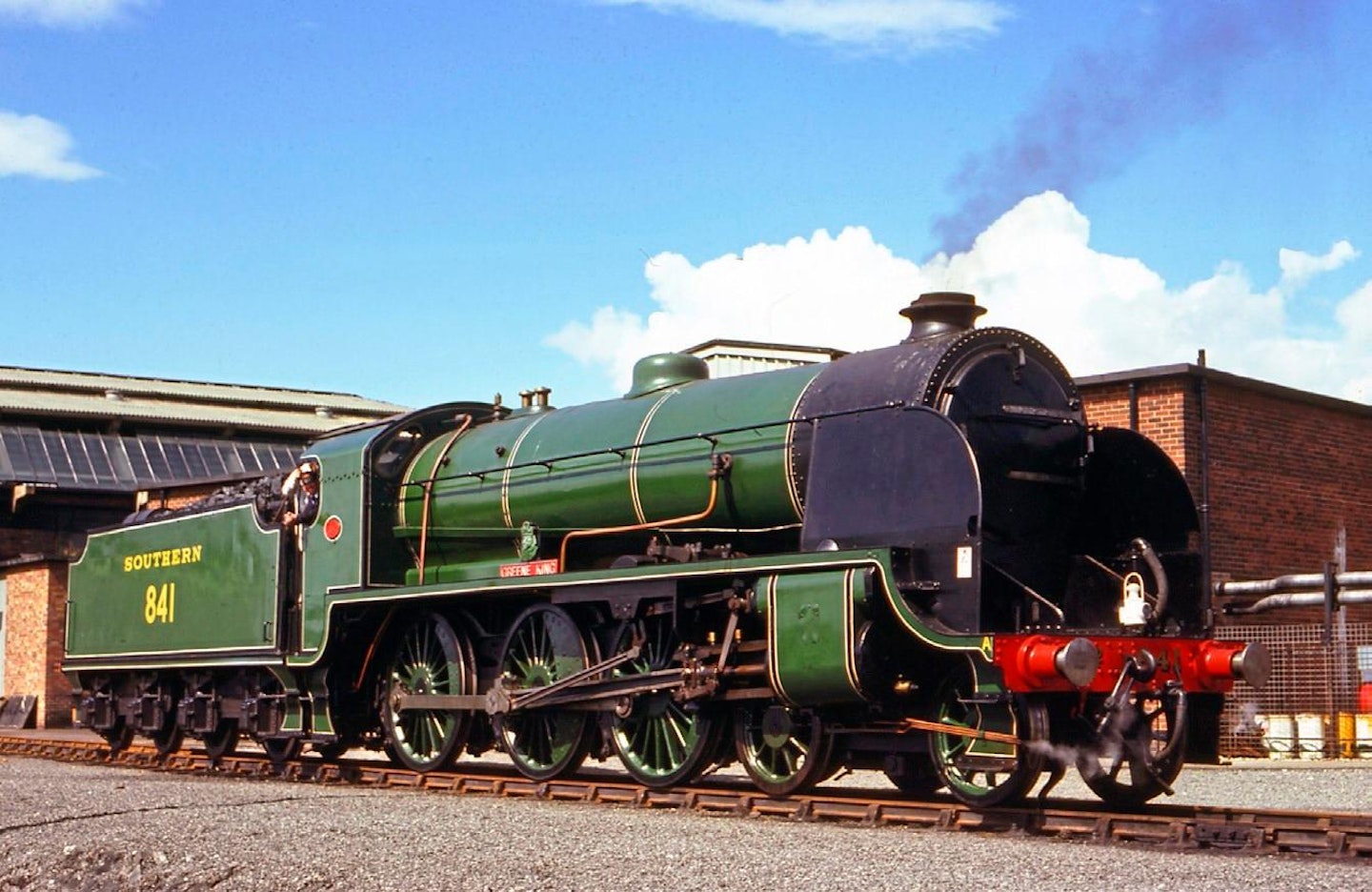
SR ‘S15’ 4 6 0 No. 841 ‘Greene King’
1975: Chappel & Wakes Colne
2025: NYMR
Status: Dismantled
The Southern Maunsell ‘S15’ 4 6 0 had an extra role at Shildon, being used for cavalcade rehearsals to check distances and timings. Hurriedly restored in Essex from derelict Berry condition between 1972-74 and named after the Bury St Edmunds brewery, it ran north in early July for wheel turning at Doncaster Works and then Gosforth, and finally Thornaby for tidying up.
No. 841 then spent some time at the Nene Valley Railway before returning north to the NYMR in 1978. Last steamed in 1994, No. 841 is unlikely to ever steam again. After its frames were discovered to be distorted, its boiler was transferred to classmate No. 825, while the frames languish in the headshunt at Grosmont, where they are rapidly returning to nature.
SR ‘Merchant Navy’ 462 No. 35028 Clan Linex
1975: Hereford
2025: Stewarts Lane
Status: Operational
Purchased from BR in 1967 in full working order, Clan Line was the only ‘Merchant Navy’ active at the time of the cavalcade, and arrived with a rake of four coaches that included fibreglass prototype No. S1000S. At the time, only two of the 10 other survivors had been rescued from Barry scrapyard, No. 35005 Canadian Pacific in March 1973, and No. 35029 Ellerman Lines in January 1974; the latter to become a sectioned exhibit at the new National Railway Museum.
Clan Line has had a very active career in preservation, having been in service from 19711980, 1984-1991, 1994-2001, 2006-2015, 20172022, and 2024 to the present day.
LMS ‘2MT’ 262T No. 41241
1975: KWVR
2025: KWVR
Status: Operational
One of the Keighley & Worth Valley Railway’s flagship engines has always stood out in the crowd because of its distinctive LMS-inspired red livery, first applied for the inaugural ‘Worth Valley’ train in June 1968. The cavalcade marked its first return to the main line since it was withdrawn from Skipton shed, and the last time the Ivatt ‘Mickey Mouse’ tank has run on the national network.
No. 41241’s latest overhaul was completed in 2018, and it was outshopped in the same KWVR livery it wore back in 1975.
LMS (BR-built) Ivatt ‘4MT’ 260 No. 43106
1975: Severn Valley Railway
2025: Severn Valley Railway
Status: Awaiting overhaul
The BR-built Ivatt ‘Mogul’ that famously began its career on the Midland & Great Northern Joint Railway system was no stranger to the main line in the 1970s, and worked to Shildon with ‘8F’ 280 No. 8233.
Preserved direct from BR at tne end of main line steam in August 1968, the ‘Flying Pig’ also took part in ‘Rocket 150’ at Rainhill in 1980, and has run over 120,000 miles in preservation, visiting many preserved lines. Its extended boiler ticket expired in January 2024 and it is expected to be some time before its overhaul commences.
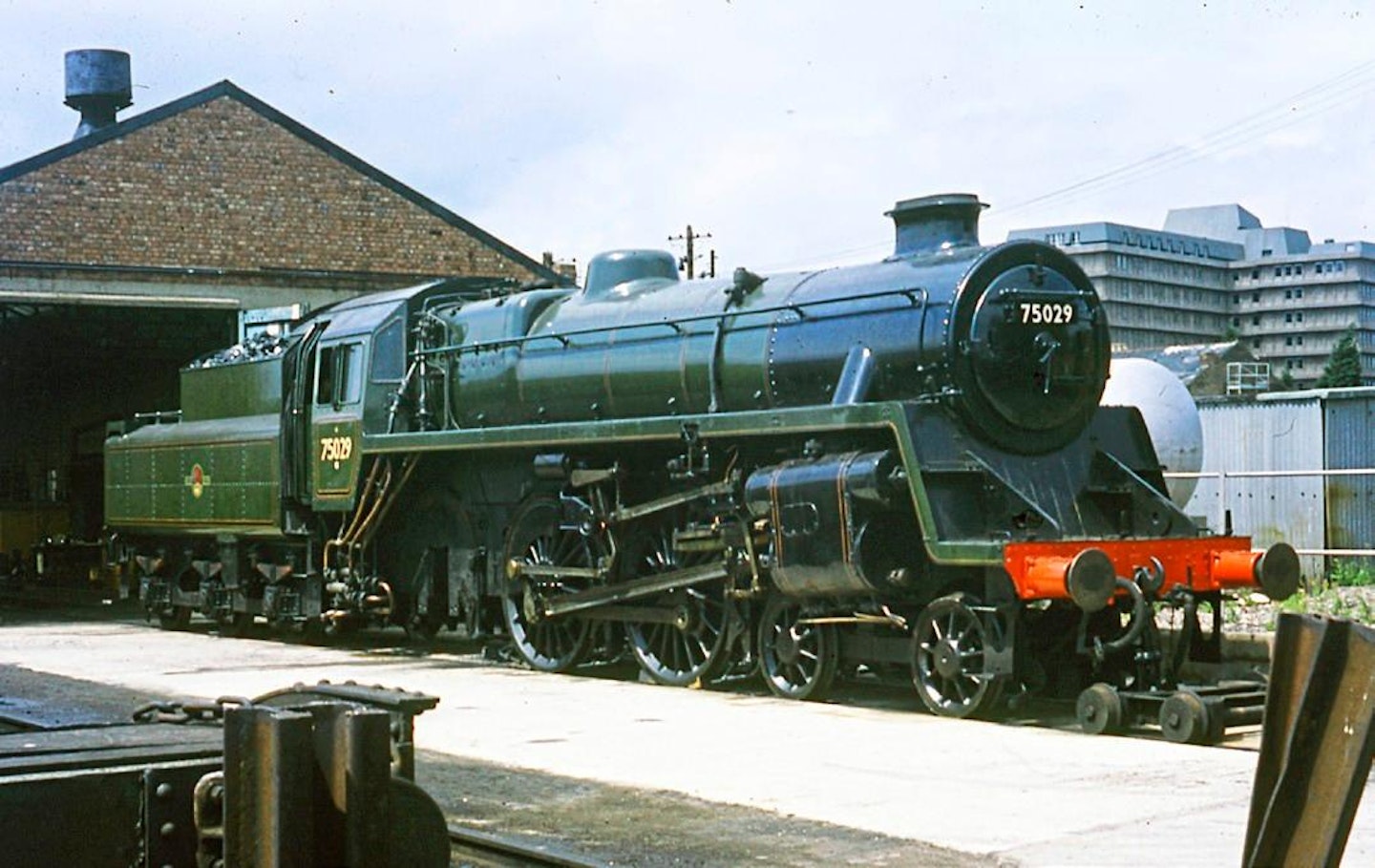
BR Standard ‘4MT’ 460 No. 75029 ‘The Green Knight’
1975: East Somerset Railway
2025: North Yorkshire Moors Railway
Status: Under overhaul
Wildlife painter and conservationist David Shepherd became well-known in 1967 following his purchases of Riddles ‘9F’ 2100 No. 92203 ‘Black Prince’ and double-chimney 460 No. 75029 straight from BR service, and the pair had a variety of homes before settling at the East Somerset Railway.
The Standard 4’s arrival in steam at Shildon was delayed by a hot box at Gloucester, so its planned excursions over the Esk Valley Line to Whitby never took place.
By chance, No. 75029 is now permanently based in the North East. It has been out of service at the NYMR since 2015 with a defective firebox, and is now subject to £200,000 appeal for a return to steam that is expected to cost twice that.

BR Standard ‘9F’ 2100 No. 92220 Evening Star
1975: KWVR
2025: National Railway Museum, York
Status: Static display
The cavalcade would not have seemed complete without BR’s final locomotive, which was thankfully in full working order at the time after a two-year spell at the KWVR. It was only 15 years old at the time, and might well have still been in regular service but for the decision to dispense with steam operation in August 1968.
After Shildon, No. 92220 was promptly transferred to the new NRM at York in 1975. It was a main line engine for a considerable time, working until 1989, but its career was ended by concerns over the ‘9Fs’ having flangeless centre driving wheels that could damage modern railway track.
BR Class 252 HST No. 252001
1975: Derby
2025: See below
Status: See below
Although reviled in 1975, time has mellowed opinions of the prototype High Speed Train, of which power car No. 41001 is now in the National Collection, having returned to service in 2014 under the custodianship of the 125 Group, before returning to the NRM in 2019. Its counterpart, No. 41002 was sadly scrapped in 1990, but most of the intermediate coaches that ran at Shildon still exist.
As a sign of how things have moved on since 1975, many production (Class 43) examples are either still in main line service, been sold for export, or are preserved.
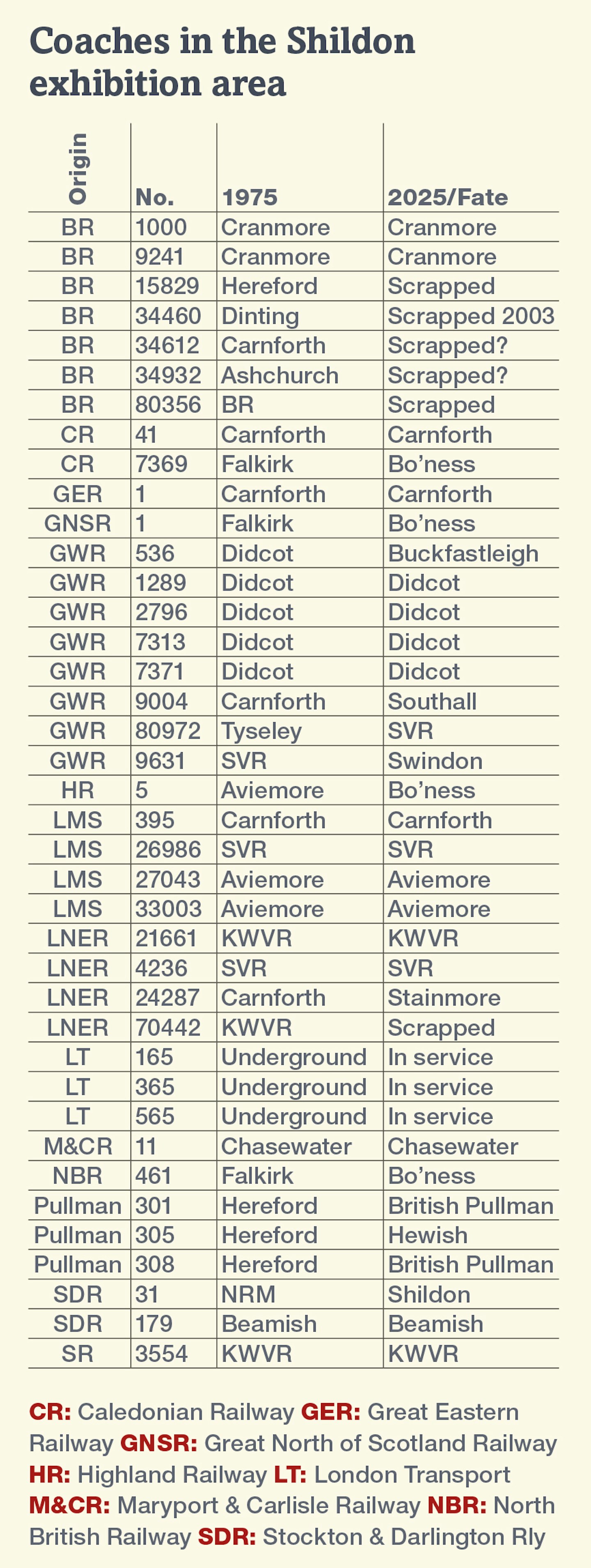
ROLLING STOCK:
There have been several casualties
Of the five dozen-plus BR DMU cars that were employed on Darlington-Shildon shuttles, only two are reckoned to survive. They are Derby-built Class 108 power car No. E50645 at the Great Central Railway (Nottingham), and Metro-Cammell Class 101 trailer No. E56062 at the North Norfolk Railway, where it has recently been reconstructed as No. 79263, a replica of the original 1955 series.
The coaching stock at the Shildon exhibition came mostly from private railways that were still in their relative infancy, sometimes after a quick repaint and with their interiors incomplete.
Many were wooden-bodied coaches that were still allowed on the national network, no longer the case (apart from a handful of exceptions) because they do not comply with modern collision impact regulations. This has impacted the Great Western Society’s historic Collett and Hawksworth rake, which went to ‘Rail 150’ but has not been allowed out since 1980.
Examining the Shildon list, time has not been kind to some of the BR Mk 1 staff support coaches that came with their engines. Scrapyard casualties have been Flying Scotsman Enterprises’ administration coach BSK No. E34612 (the body may still exist in Somerset), Bulmer’s Railway Centre’s (Hereford) CK No. W15829, sales coach BSK No. M34460 from Dinting, and possibly Ashchurch BSK No. W34932 (fate unknown). LNER pigeon van No. E70442E, at the KWVR in 1975, has been dismantled at the SVR to reuse its frames. BR Mk 1 postal van No. W80346 also no longer exists.
The three 1951 ‘Golden Arrow’ Pullman coaches at seen at ‘Rail 150’ have changed their careers since 1975. Two of them, Parlour Firsts Perseus (part of Sir Winston Churchill’s funeral train in 1965) and Cygnus – formerly owned by Scottish & Newcastle Breweries (now Heineken) – were kept at the now defunct Bulmer’s Railway Centre at Hereford, and are still main line-registered as part of the Belmond ‘British Pullman’ fleet.
The third Pullman, First Class Kitchen Aquila, is a restaurant at the Garden Park Garden Centre at Hewish, near Weston Super--Mare. It was also once at Hereford, but has passed through the Venice Simplon Orient Express in 1986, Colne Valley, South Devon and finally Bluebell Railway, where its limited seating made it uneconomic to operate.
Finally, London Underground’s three-car Piccadilly Line unit is still in daily public service between Cockfosters and Heathrow Airport, but perhaps only for another year. A preservation candidate maybe?
Each issue of Steam Railway delivers a wealth of information that spans the past, present and future of our beloved railways. Featuring stunning photography, exclusive stories and expert analysis, Steam Railway is a collector's item for every railway enthusiast.
Choose the right subscription for you and get instant digital access to the latest issue.

